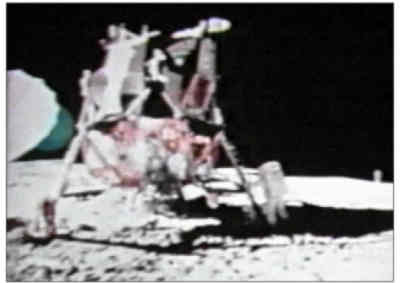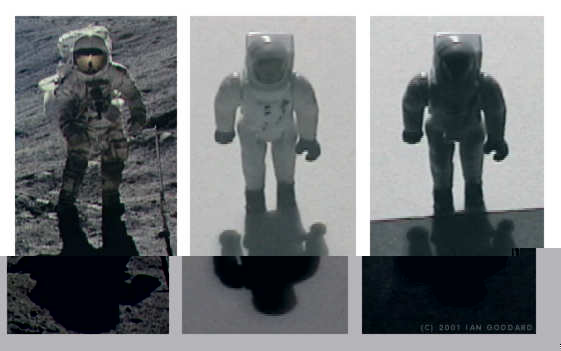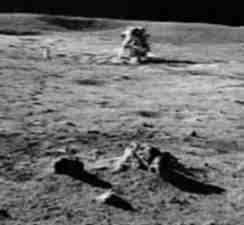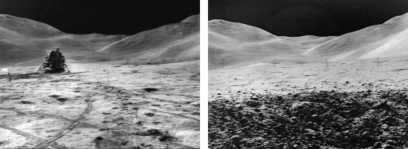Apollo Moon landing photos were fakes!
-
"Did we actually send humans to the Moon in the 1960's? Of course we did! But some people are claiming that NASA lied about the Apollo program, that we faked the landings. Actually, it would have been harder to fake the whole thing than to do it! But many people are confused about it, and have asked NASA to clear it up.
The current confusion began with a TV program called "Conspiracy Theory: Did We Land on the Moon?" aired on February 15th, and again on March 21st, 2001. The program interviewed people who doubted NASA had the technology to make it to the Moon. They felt that the USA was so eager to win the "Space Race" against the Soviet Union, NASA acted out the Apollo space program in movie studios! They claimed astronaut Neil Armstrong's historic first steps on the Moon, planting the American flag, the bouncy Moon Buggy rides, and even Astronaut Al Shepard's golf shot, were all fake.
But not only did they claim NASA faked the whole thing, but that we did it very poorly! The so-called "experts" on Conspiracy Theory pointed out a number of things they thought were "errors." Well, let's look at a couple of them:
Stars in the Lunar Sky
Pictures of astronauts sent from the Moon don't include stars in the dark lunar sky. How could that be? Did NASA's film makers forget to turn on the stars? Most people who take photos know the answer: it's hard to take a picture of something very bright and something else very dim on the same photo. Ever watch a TV program or movie with outdoor night scenes? Unless the movie producers fake stars in the sky, or use special cameras, you just don't see stars. The cameras are adjusted for the actors, and the stars in the background are too dim to see. "
A Waving Flag
Everyone has seen the video of astronauts planting a US flag on the Moon. You can see the flag flexing and rippling. How can that be? There's no breeze on the Moon. But then, there's no atmosphere, either. When the astronauts planted the flagpole they twisted it back and forth to sink it into the lunar soil. On the Earth, that would have made the flag "wave" for a few seconds, then stop. But that's because the flag pushes against air as it flaps, and the air slows it down. On the Moon, there was no air to stop the flag's motion, so it continued, just as Newton's First Law of physics says it should. So of course the cloth flag waved and rippled beneath the metal rod holding it out. -

"On the Moon, the astronaut's only source of light was the Sun. ... Here's an astronaut who descends into the huge shadow caste from the lunar module, yet his entire body is still visible. How is it that he is not shrouded in darkness?" Apollo skeptic answers: "It's because there's more than one light source, which means they're not on the Moon."
"In this picture the Sun is directly behind the astronaut, his figure should be a silhouette, yet even the smallest characteristics of his suit are recognizable." A photographic expert then says: "He seems like he's standing in the spotlight. I can't explain that."
"On the Moon, the astronaut's only source of light was the Sun. Yet in this photograph from Apollo 14, the shadows are caste in different directions suggesting multiple light sources." Dave Percy: "The shadows caste by the rocks in the foreground should have been east-west like the LEM [lunar module] shadow."
These two photos seem to have the same mountain backdrop, yet the lunar module is only visible in one of them. Seemingly impossible since the LEM never moved, and its based remained even after the mission. Some suggest the same artificial backdrop was used when shooting two entirely separate pictures -
nw than u know ah, this is old news liao leh dey....

-
dude...i also knew that long agoOriginally posted by De|usi0n:nw than u know ah, this is old news liao leh dey....

just that now then post mah...for the benefit of the ppl who dunno...
-
so....is it true or not??
-
This world got too many conspiracies around.......especially when comes to politics.....

-
Which one do you mean dude?Originally posted by NeonTetra:so....is it true or not??
The landing or the hoax? -
Aiyah, the light problem is retarded lah... It's called radiosity... Sunlight is simply reflected off the surroundings and diffused all around. Anybody who does 3d modeling will know this principal.
The backdrop mountain thing is also pretty retarded. If you look closely, you realize they are actually different. And a multi-million dollar hoaxer must be pretty retarded if he missed that detail.
Those pple are grasping at straws here. But no matter, that was all in the past. -
maybe nobody has landed on the moon before..
-
Humans create nice and beautiful stories for us to enjoy..
i wonder why there are people in this world that wanna destroy them ..
hai ...
-
You guys can find more interesting info abt this topic in this flash sequence about the fake moon landings
